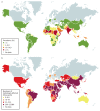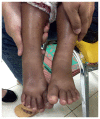Severe childhood malnutrition
- PMID: 28933421
- PMCID: PMC7004825
- DOI: 10.1038/nrdp.2017.67
Severe childhood malnutrition
Abstract
The main forms of childhood malnutrition occur predominantly in children <5 years of age living in low-income and middle-income countries and include stunting, wasting and kwashiorkor, of which severe wasting and kwashiorkor are commonly referred to as severe acute malnutrition. Here, we use the term 'severe malnutrition' to describe these conditions to better reflect the contributions of chronic poverty, poor living conditions with pervasive deficits in sanitation and hygiene, a high prevalence of infectious diseases and environmental insults, food insecurity, poor maternal and fetal nutritional status and suboptimal nutritional intake in infancy and early childhood. Children with severe malnutrition have an increased risk of serious illness and death, primarily from acute infectious diseases. International growth standards are used for the diagnosis of severe malnutrition and provide therapeutic end points. The early detection of severe wasting and kwashiorkor and outpatient therapy for these conditions using ready-to-use therapeutic foods form the cornerstone of modern therapy, and only a small percentage of children require inpatient care. However, the normalization of physiological and metabolic functions in children with malnutrition is challenging, and children remain at high risk of relapse and death. Further research is urgently needed to improve our understanding of the pathophysiology of severe malnutrition, especially the mechanisms causing kwashiorkor, and to develop new interventions for prevention and treatment.
Conflict of interest statement
The authors declare no competing interests.
Figures






References
-
- United Nations. Sustainable development goal 2. United Nations; 2015. https://sustainabledevelopment.un.org/sdg2.
-
- Black RE, et al. Maternal and child undernutrition and overweight in low-income and middle-income countries. Lancet. 2013;382:427–451. [This is an important global review of the epidemiology, major risk factors and consequences of malnutrition.] - PubMed
-
- McDonald CM, et al. The effect of multiple anthropometric deficits on child mortality: meta-analysis of individual data in 10 prospective studies from developing countries. Am J Clin Nutr. 2013;97:896–901. [This review of data from ten prospective cohorts summarized the observed association of major anthropometric deficits and the additive effects of infections on risks of death in childhood.] - PubMed
Publication types
MeSH terms
Grants and funding
LinkOut - more resources
Full Text Sources
Other Literature Sources
Medical

